Have you ever wondered how to properly target and strengthen your hamstrings during your leg workout? Well, you’re in luck because we’re about to dive into the ultimate guide to hack squat for hamstrings!
Whether you’re a gym enthusiast or just looking to switch up your exercise routine, this guide will provide you with all the tips and tricks you need to know to maximize your hamstring gains.
In this article, we’ll discuss the hack squat exercise in detail and how it specifically targets your hamstrings. We’ll explore the correct foot placement and technique to ensure you’re getting the most out of this exercise.
Additionally, we’ll provide you with some valuable tips and variations to apply during your hack squat routine. So, get ready to learn all there is to know about hack squat for hamstrings and take your leg day to the next level!
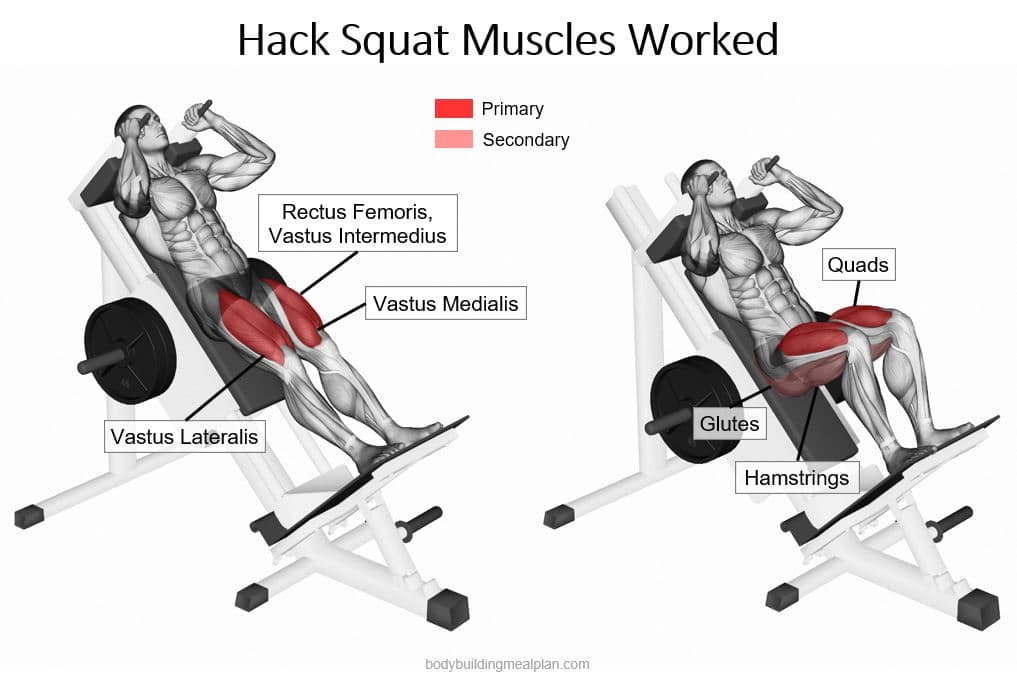
What is the Hack Squat exercise?
Definition of Hack Squat
The Hack Squat exercise is a popular and effective lower body exercise that targets the muscles in your hamstrings, glutes, quads, and calves. It involves using a Hack Squat machine, which is specifically designed for this exercise.
Targeted muscles
The primary muscles targeted during the Hack Squat exercise are the hamstrings. These muscles are responsible for flexing the knee joint and extending the hip joint. Additionally, the glutes, quads, and calves also play a secondary role in this exercise, helping to stabilize and support the movement.
Importance of Hack Squat for hamstrings
The hamstrings play a crucial role in everyday movements such as walking, running, and jumping. Strengthening these muscles can improve athletic performance, prevent injuries, and enhance overall lower body strength. The Hack Squat exercise specifically targets and strengthens the hamstrings, making it an essential exercise for anyone looking to develop strong and well-rounded legs.
Proper form and technique for Hack Squat
To get the most out of your Hack Squat exercise and prevent injuries, it’s important to maintain proper form and technique throughout the movement.
Foot placement
Start by positioning your feet shoulder-width apart on the platform. The placement of your feet will determine which muscles are targeted more. Placing your feet higher on the platform will shift the emphasis to the quads, while placing them lower will engage the hamstrings and glutes more.
Back and core positioning
Maintain a neutral spine throughout the exercise to avoid back strain. Keep your chest lifted, shoulders back, and core engaged. Avoid rounding or arching your back, as this can lead to poor form and potential injuries.
Range of motion
Lower the platform by bending your knees and hips until your thighs are parallel to the ground or slightly lower. It’s important to maintain control and avoid bouncing at the bottom of the movement. Then, push through your heels and extend your knees and hips to return to the starting position.
Breathing technique
Inhale as you lower the platform and exhale as you push back up. Proper breathing technique helps stabilize your core and promotes efficient muscle activation.
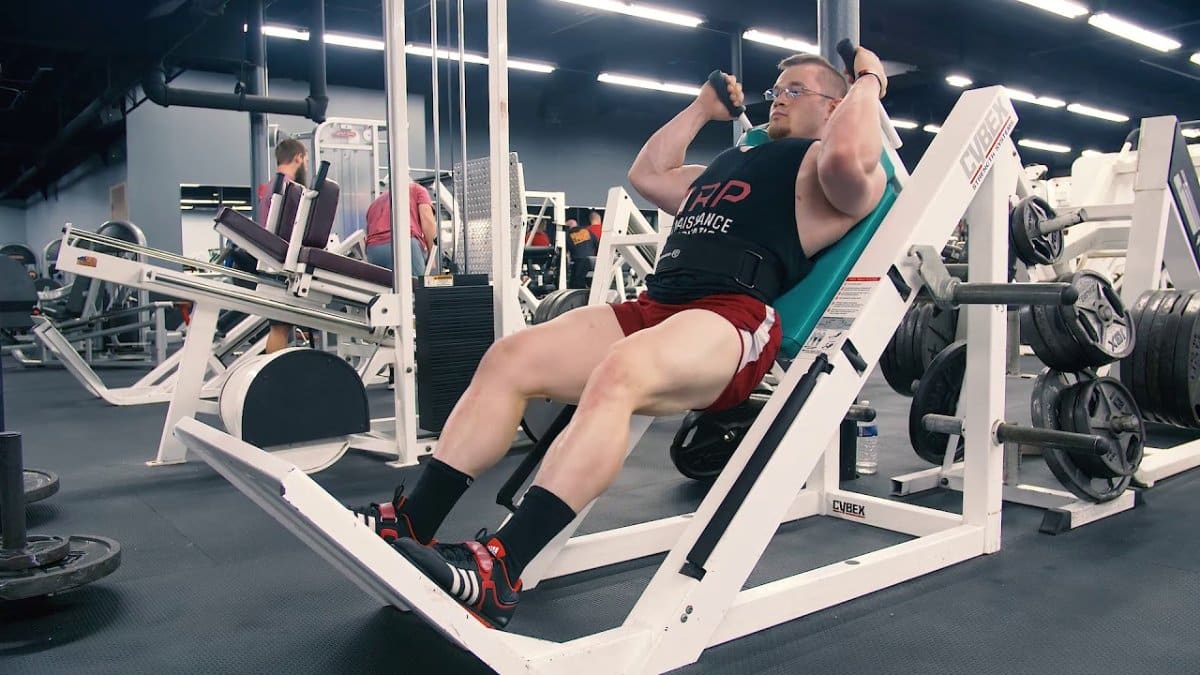
Benefits of Hack Squat for hamstrings
Increased muscle activation
The Hack Squat exercise specifically targets the hamstrings, resulting in increased muscle activation. This means that the exercise effectively engages and strengthens the hamstrings, helping to develop stronger and more functional leg muscles.
Improved hamstring strength
By consistently incorporating Hack Squats into your workout routine, you can significantly improve hamstring strength. The exercise places a strong demand on the hamstrings, forcing them to adapt and grow stronger over time. This enhanced strength can improve athletic performance, increase running speed, and enhance overall leg power.
Enhanced knee stability
Strong hamstrings play a crucial role in providing stability and support to the knee joint. By regularly performing the Hack Squat exercise, you can strengthen the hamstrings, reducing the risk of knee injuries and improving knee stability. This is particularly beneficial for athletes involved in activities that require sudden changes in direction or high-impact movements.
Building overall lower body strength
In addition to targeting the hamstrings, the Hack Squat exercise also engages the glutes, quads, and calves. This makes it a compound exercise that helps build overall lower body strength. Strong and well-developed leg muscles can improve functional movements, enhance athletic performance, and support daily activities.
Common mistakes to avoid during Hack Squat
To maximize the benefits of the Hack Squat exercise and reduce the risk of injury, it’s important to avoid these common mistakes:
Incorrect foot positioning
Placing your feet too high or too low on the platform can shift the emphasis to the wrong muscle groups. Keep your feet at a position that targets the hamstrings effectively. Experiment with different foot placements to find the position that feels most comfortable and engages the hamstrings the most.
Round back
Maintaining a rounded back during the Hack Squat exercise can put excessive stress on your spine and increase the risk of injury. Keep your back straight and your chest lifted throughout the movement to maintain proper form and minimize strain on your back.
Incomplete range of motion
Not lowering the platform enough or stopping short of fully extending your knees and hips can limit the effectiveness of the exercise. Aim to achieve a parallel or slightly lower position with your thighs at the bottom of the movement, and fully extend your knees and hips at the top.
Using momentum
Using momentum to lift the weight can take the focus away from the target muscles and increase the risk of injury. Instead, focus on controlled and deliberate movement throughout the exercise. If you find yourself using momentum, consider reducing the weight to maintain proper form and ensure optimal muscle engagement.
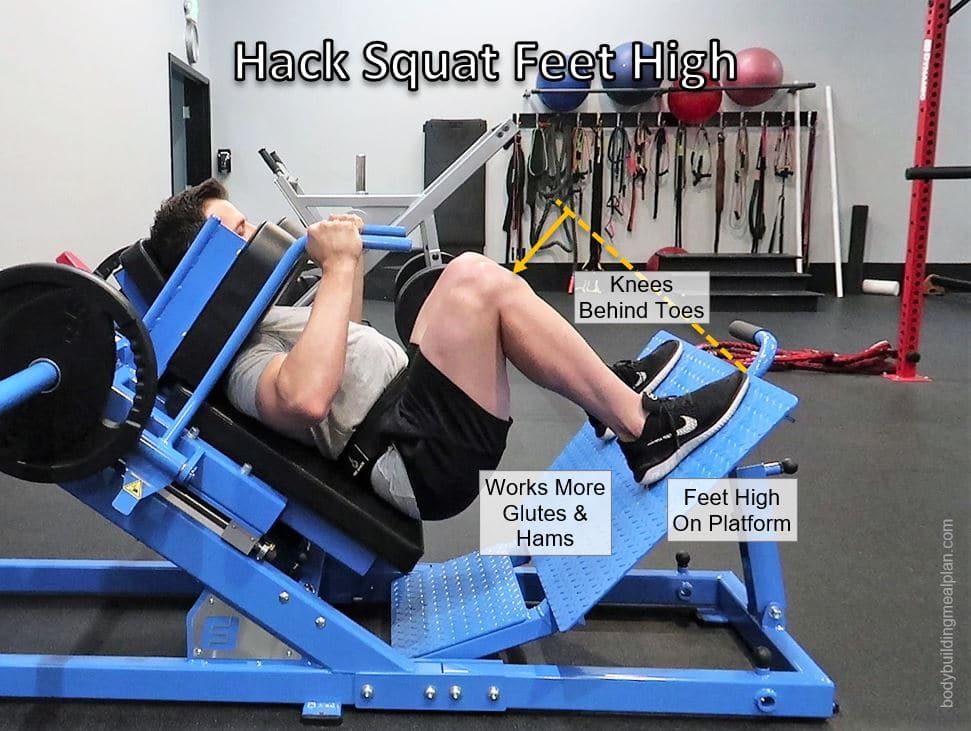
Variations of the Hack Squat exercise
While the traditional Hack Squat exercise is highly effective, there are also variations that can target the hamstrings and provide additional benefits. These variations include:
Narrow stance Hack Squat
This variation involves placing your feet closer together on the platform, which increases the emphasis on the quads. However, the hamstrings are still engaged in the movement and benefit from the exercise.
Sumo stance Hack Squat
In this variation, your feet are positioned wider than shoulder-width apart and toes are pointed outward. This targets the inner thighs, glutes, and hamstrings, providing a different stimulus to the muscles.
Single-leg Hack Squat
This variation involves performing the exercise with one leg at a time. This challenges your balance and engages the hamstrings more intensely, as they work to stabilize the movement. It’s important to start with lighter weights and gradually progress as you build strength and stability.
Pause Hack Squat
This variation incorporates a pause at the bottom of the movement, increasing the time under tension for the muscles. This can enhance muscle growth and strength development.
Precautions and tips for performing Hack Squat
To ensure a safe and effective Hack Squat exercise, consider the following precautions and tips:
Warm-up and stretching
Before starting any exercise, it’s important to warm up your muscles and prepare them for the workout. Incorporate dynamic stretches and perform a few sets of lighter weight Hack Squats to warm up the specific muscles you’ll be targeting.
Appropriate weight selection
Choose a weight that challenges you but allows you to maintain proper form and complete the desired number of repetitions. Using too much weight can compromise your form and increase the risk of injury, while using too little weight may not provide enough stimulus for muscle growth.
Progression and gradual overload
As with any exercise, it’s important to progressively increase the weight or intensity over time. This gradual overload stimulates muscle growth and prevents plateauing. Start with a weight that allows you to perform the exercise with proper form, and increase the weight gradually as your strength improves.
Proper recovery and rest
Allow your muscles adequate time to recover and rest between Hack Squat workouts. This allows for muscle repair and growth. Include rest days in your training schedule and prioritize getting enough sleep and proper nutrition to support muscle recovery.
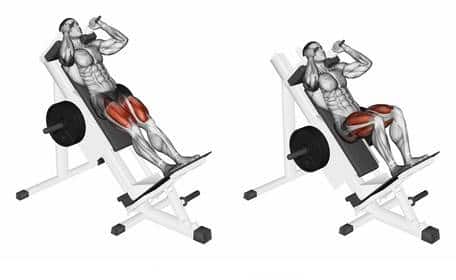
How to incorporate Hack Squat into your workout routine?
Frequency of Hack Squat
The frequency of Hack Squat workouts will depend on your overall training program and goals. For most individuals, performing Hack Squats once or twice a week can be sufficient to effectively target and strengthen the hamstrings. However, it’s important to listen to your body and adjust the frequency based on how you feel and your recovery capacity.
Recommended sets and reps
Aim for 3-4 sets of 8-12 repetitions for the Hack Squat exercise. This rep range is ideal for muscle hypertrophy and strength development. Adjust the weight accordingly to ensure that you reach muscular fatigue within the desired rep range on the last set of each exercise.
Combining with other hamstring exercises
While the Hack Squat exercise is effective for targeting the hamstrings, it’s beneficial to incorporate a variety of exercises that target the hamstrings from different angles and movements. Good complementary exercises include Romanian deadlifts, leg curls, and walking lunges.
Tracking progress
Keep a record of the weight used, sets, reps, and any modifications you make to your Hack Squat workouts. This will help you track your progress over time and make informed decisions about increasing weight or adjusting your training program.
Potential risks and injury prevention
While the Hack Squat exercise is generally safe when performed with proper form and technique, there are potential risks and injuries to be aware of. These include:
Knee strain or injury
The Hack Squat exercise places stress on the knees, so it’s important to maintain proper form and avoid excessive forward knee movement. If you have pre-existing knee issues or limitations, consult with a healthcare professional before incorporating Hack Squats into your routine.
Back strain
Poor form, such as rounding the back or using excessive weight, can lead to back strain. Focus on maintaining a neutral spine throughout the exercise and only use a weight that allows for proper form and control. If you experience any back pain or discomfort during the exercise, consult with a fitness professional or healthcare provider.
Muscle imbalances
Focusing solely on the Hack Squat exercise for your hamstring training can lead to muscle imbalances, particularly if other muscle groups are neglected. It’s important to incorporate a well-rounded lower body workout routine that targets all major muscle groups.
Overtraining
Overtraining can occur if you perform the Hack Squat exercise too frequently or with excessive intensity without adequate rest and recovery. This can lead to decreased performance, increased risk of injury, and hindered progress. Listen to your body, prioritize rest days, and adjust your training volume and intensity accordingly to avoid overtraining.
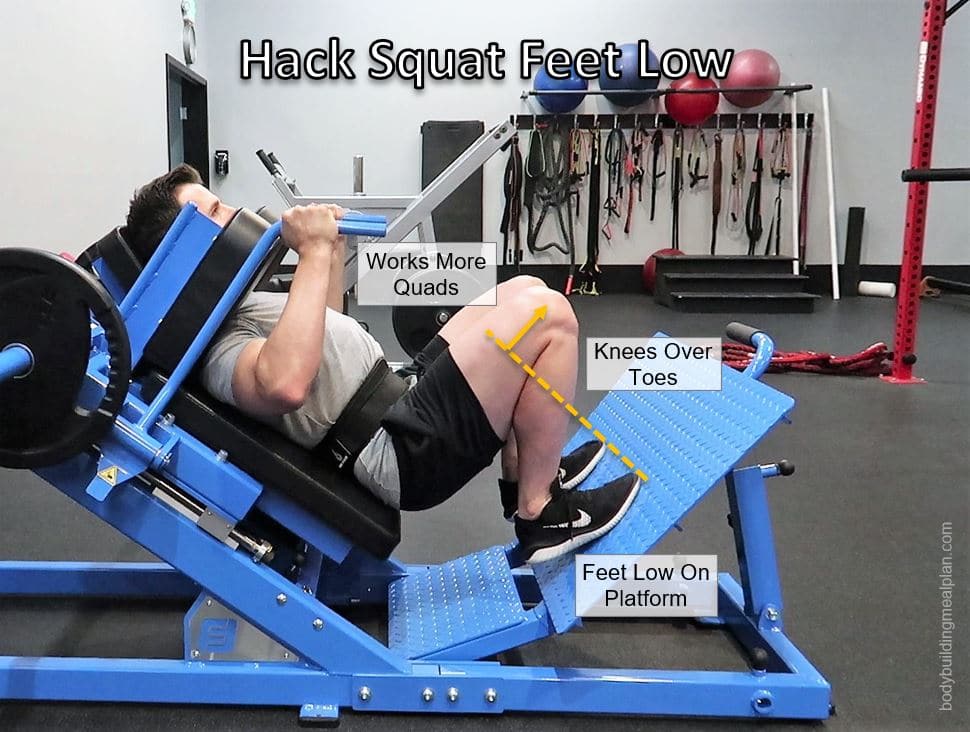
Frequently asked questions about Hack Squat
Is Hack Squat suitable for beginners?
The Hack Squat exercise can be suitable for beginners, but it’s crucial to master proper form and technique before adding weight. Start with bodyweight or the lightest weight available on the machine and focus on developing a strong mind-muscle connection. Work with a fitness professional to ensure you’re performing the exercise correctly.
Can Hack Squat replace traditional squats?
While the Hack Squat exercise targets similar muscle groups as traditional squats, it should not replace them altogether. Both exercises have their own unique benefits and variations. Incorporating a mix of both exercises into your lower body workout routine can help build overall lower body strength and prevent muscle imbalances.
How often should I perform Hack Squat?
The frequency of Hack Squat workouts will depend on your overall training program and goals. Aim to perform Hack Squats once or twice a week, and adjust the frequency based on your recovery capacity and individual needs. It’s important to listen to your body and prioritize rest and recovery.
Can Hack Squat lead to muscle imbalances?
While the Hack Squat exercise primarily targets the hamstrings, it’s important to incorporate exercises that target all major muscle groups in the lower body. Neglecting other muscle groups can lead to muscle imbalances and potential injury. It’s beneficial to include a variety of exercises in your workout routine to ensure a well-rounded and balanced lower body development.
Conclusion
The Hack Squat exercise is a valuable addition to any lower body workout routine, especially if you’re looking to target and strengthen your hamstrings. By following proper form and technique, you can maximize the benefits while minimizing the risk of injury.
Incorporating the Hack Squat exercise, along with complementary exercises and a well-rounded training program, can help you develop stronger hamstrings, improve overall lower body strength, and enhance your athletic performance. Remember to progress gradually, prioritize recovery, and listen to your body for optimal results.




